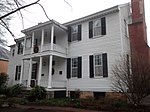North Carolina Department of Military and Veterans Affairs
2015 establishments in North CarolinaGovernment of North CarolinaNorth Carolina CabinetNorth Carolina stubsState agencies of North Carolina ... and 1 more
Use American English from August 2015

The North Carolina Department of Military and Veterans Affairs (DMVA) is a state agency designed to advocate for the relationship the state has with its military and veterans' installations and populations. It was created by the North Carolina General Assembly with the support of Governor Pat McCrory. The current head of the Department is Secretary Walter E. Gaskin. Prior to the creation of the Department, the Division of Veterans Affairs was under the Department of Administration while all military-related matters fell under the Department of Commerce.
Excerpt from the Wikipedia article North Carolina Department of Military and Veterans Affairs (License: CC BY-SA 3.0, Authors, Images).North Carolina Department of Military and Veterans Affairs
North Salisbury Street, Raleigh Seaboard Station
Geographical coordinates (GPS) Address Nearby Places Show on map
Geographical coordinates (GPS)
| Latitude | Longitude |
|---|---|
| N 35.785555555556 ° | E -78.639722222222 ° |
Address
North Salisbury Street
27603 Raleigh, Seaboard Station
North Carolina, United States
Open on Google Maps









